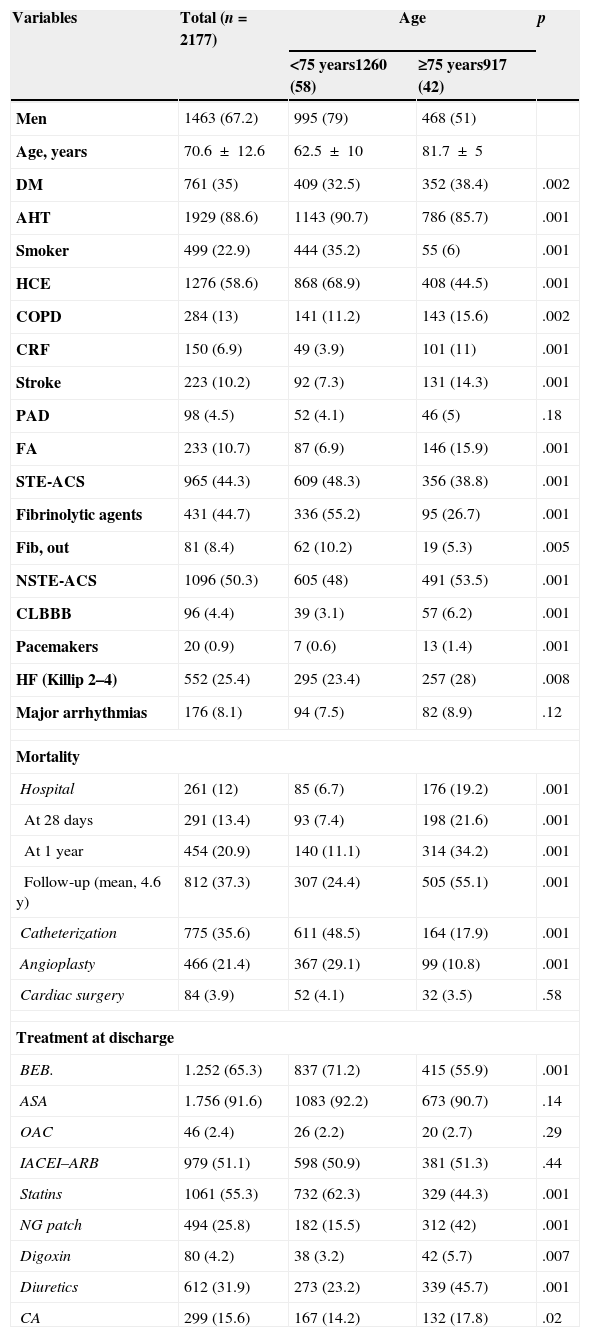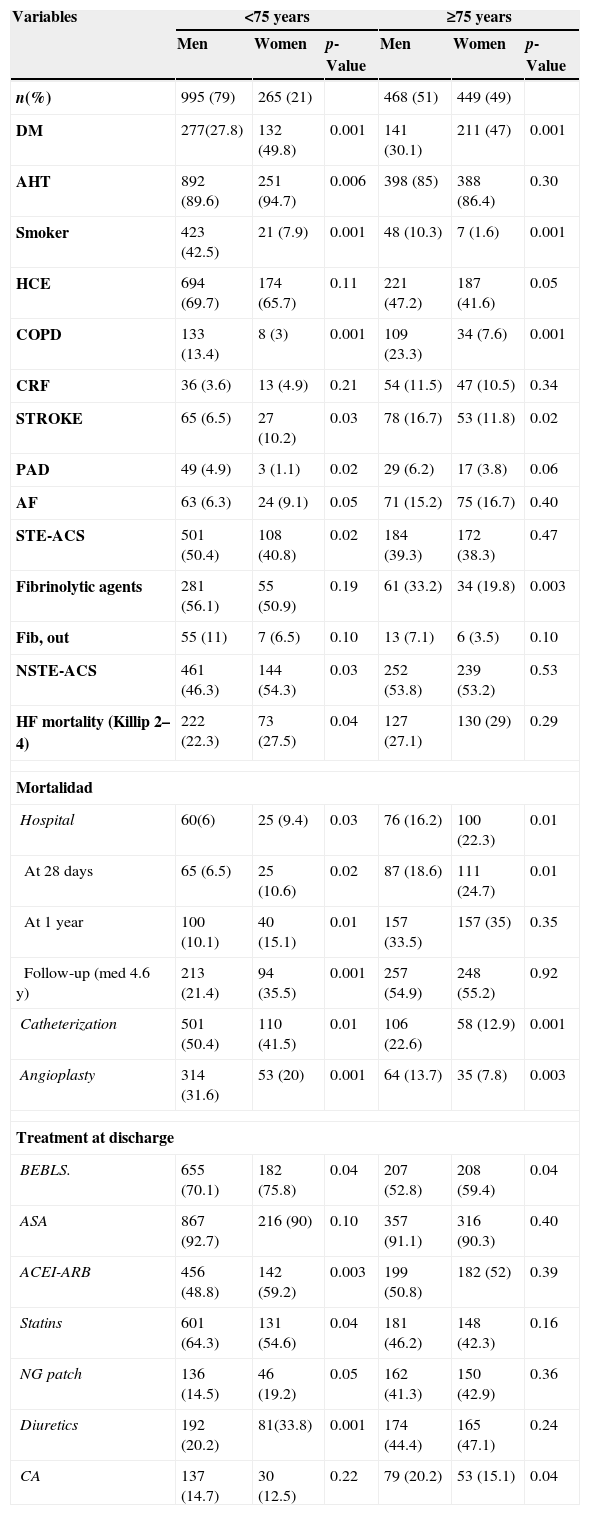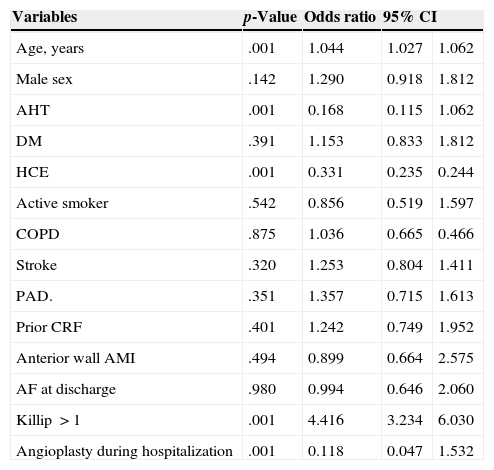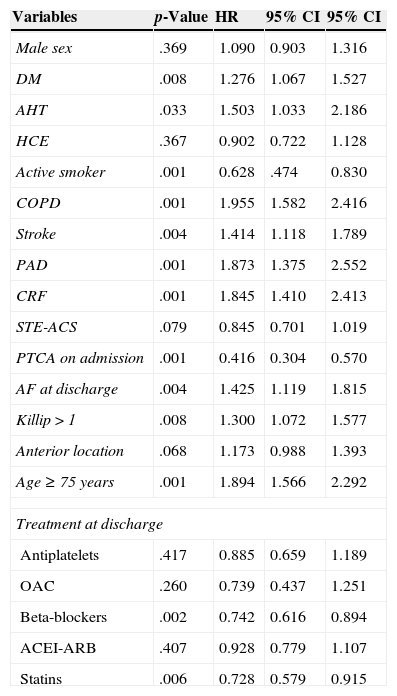Elderly patients with acute myocardial infarction constitute a population that is not adequately represented in clinical trials or medical registries. Our objective was to compare the clinical characteristics, treatments administered and mortality among patients younger and older than 75 years.
Materials and methodsObservational retrospective study of patients hospitalized for acute myocardial infarction in the decade 2000–2009. Multivariate models were constructed to determine hospital and late mortality (median, 4.6 years; IQR 25–75: 2.1–7.3).
ResultsWe included 2177 patients (995 men [79%]), with a mean age of 70.8 years (SD, 12.6). A total of 917 (42.0%) of the patients were 75 years of age or older. When compared with the patients younger than 75 years, the older patients had a greater prevalence of diabetes (38.3% vs. 32.5%; P<.002), chronic obstructive pulmonary disease (15.6% vs. 11.2%; P<.002), stroke (14.3% vs. 7.3%; P<.001), chronic renal failure (11.0% vs. 3.9%; P<.001), atrial fibrillation (15.9% vs. 6.9%; P<.001), heart failure (28.0% vs. 23.4%; P<.008). The older patients were treated with fewer beta-blockers (55.9% vs. 71.2%; P<.001), statins (44.3% vs. 62.3%; P<.001), coronary angiographies (17.9% vs. 48.5%; P<.001) and angioplasties (10.8% vs. 29.1%; P<.001). The patients older than 75 years had lower survival (mortality, 44.5% vs. 18.9%; HR 1.89; 95% CI 1.57–2.29). The use of beta-blockers (HR, 0.74; 95% CI 0.62–0.89), statins (HR 0.73; 95% CI 0.58–0.91) and angioplasty (HR, 0.42; 95% CI 0.30–0.57) was inversely correlated with mortality.
ConclusionsPatients older than 75 years with acute myocardial infarction had lower survival and were treated with fewer beta-blockers, statins and angioplasty, indications that are associated with lower mortality.
Los ancianos con infarto agudo de miocardio constituyen una población que no está adecuadamente representada en ensayos clínicos ni en registros médicos. Nuestro objetivo fue comparar, entre pacientes menores y mayores de 75 años, las características clínicas, los tratamientos administrados y la mortalidad.
Material y métodosEstudio observacional y retrospectivo de pacientes ingresados por infarto agudo de miocardio en la década 2000-09. Se construyeron modelos multivariados para estimar mortalidad hospitalaria y tardía (mediana 4,6 años; RI 25-75: 2,1-7,3).
ResultadosSe incluyeron 2.177 pacientes (hombres 995 [79%]) con una edad media de 70,8 años (DE: 12,6). Un total de 917 (42,0%) tenían 75 años o más. Estos enfermos comparados con los menores de 75 años presentaron mayor prevalencia de diabetes (38,3 vs. 32,5%; p<0,002), enfermedad pulmonar obstructiva crónica (15,6 vs. 11,2%; p<0,002), ictus (14,3 vs. 7,3%; p<0,001), insuficiencia renal crónica (11 vs. 3,9%; p<0,001), fibrilación auricular (15,9 vs. 6,9%; p<0,001), insuficiencia cardiaca (28 vs. 23,4%; p<0,008). Recibieron menos betabloqueantes (55,9 vs.71,2%; p<0,001) y estatinas (44,3 vs. 62,3%; p<0,001), se les realizaron menos coronariografías (17,9 vs. 48,5%; p<0,001) y angioplastias (10,8 vs. 29,1; p<0,001). Los mayores de 75 años mostraron una menor supervivencia (mortalidad 44,5 vs. 18,9%), HR 1,89 (IC 95%: 1,57-2,29), asociándose inversamente con la mortalidad tardía: betabloqueantes (HR=0,74; IC 95%: 0,62-0,89), estatinas (HR: 0,73; IC 95%: 0,58-0,91) y angioplastias (HR=0,42; IC 95%: 0,30-0,57).
ConclusionesLos pacientes mayores de 75 años con infarto agudo de miocardio tuvieron menor supervivencia y recibieron menos betabloqueantes, estatinas y angioplastias, indicaciones que se asocian a una menor mortalidad.
Article
Diríjase desde aquí a la web de la >>>FESEMI<<< e inicie sesión mediante el formulario que se encuentra en la barra superior, pulsando sobre el candado.

Una vez autentificado, en la misma web de FESEMI, en el menú superior, elija la opción deseada.

>>>FESEMI<<<












